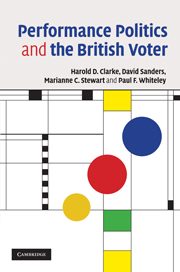Book contents
- Frontmatter
- Contents
- List of figures
- List of tables
- Acknowledgments
- 1 Performance politics and the British voter
- 2 The theory of valence politics
- 3 Valence politics and the long campaign
- 4 Tony's war
- 5 Electoral choices
- 6 The short campaign
- 7 Voting and political participation
- 8 Performance, people and the political system
- 9 Performance politics reconsidered
- Appendix A Vote in 2005 by socio-demographic characteristics
- Appendix B Turnout by socio-demographic characteristics
- Appendix C Dynamics of party identification
- Notes
- Bibliography
- Index
Appendix C - Dynamics of party identification
Published online by Cambridge University Press: 06 January 2010
- Frontmatter
- Contents
- List of figures
- List of tables
- Acknowledgments
- 1 Performance politics and the British voter
- 2 The theory of valence politics
- 3 Valence politics and the long campaign
- 4 Tony's war
- 5 Electoral choices
- 6 The short campaign
- 7 Voting and political participation
- 8 Performance, people and the political system
- 9 Performance politics reconsidered
- Appendix A Vote in 2005 by socio-demographic characteristics
- Appendix B Turnout by socio-demographic characteristics
- Appendix C Dynamics of party identification
- Notes
- Bibliography
- Index
Summary
The valence politics view of party identification differs in crucial respects from the original social psychological conceptualization. In its classic ‘Michigan’ formulation, party identification is a long–term psychological attachment between a voter and a political party similar to identifications people form with ethnic, religious or other social groups (Campbell et al., 1960; see also Butler and Stokes, 1969). Michigan–style party identifications typically develop early in the life–cycle as a result of childhood and adolescent socialization processes and, except in periods of realignment, they tend to be directionally stable, strengthening in intensity as people age (Converse, 1969). Party identification is an ‘unmoved mover’ in the funnel of causal forces determining the vote — it exerts powerful direct effects and acts as a ‘perceptual screen’ that shapes images of candidates, issues and party leaders.
The valence politics model accepts the idea that partisan attachments have important direct and indirect effects on electoral choice. However, the model claims that these attachments have dynamic qualities, and are subject to change in response to ongoing evaluations of actual or anticipated performance of political parties and their leaders. This notion of partisanship as a ‘running tally’ of current and discounted past performance evaluations was originally developed by Fiorina (1981), and over the past quarter–century it has been featured in a number of studies (e.g. Achen, 1992, 2002; Franklin, 1984, 1992; Franklin and Jackson, 1983; Stewart and Clarke, 1998). However, the conjecture that partisan attachments manifest dynamic properties remains controversial (e.g. Green et al., 2002).
Panel data gathered since the 1960s provide strong prima facie evidence that party identification in Britain exhibits substantial individual–level change over relatively modest time intervals.
- Type
- Chapter
- Information
- Performance Politics and the British Voter , pp. 327 - 330Publisher: Cambridge University PressPrint publication year: 2009



